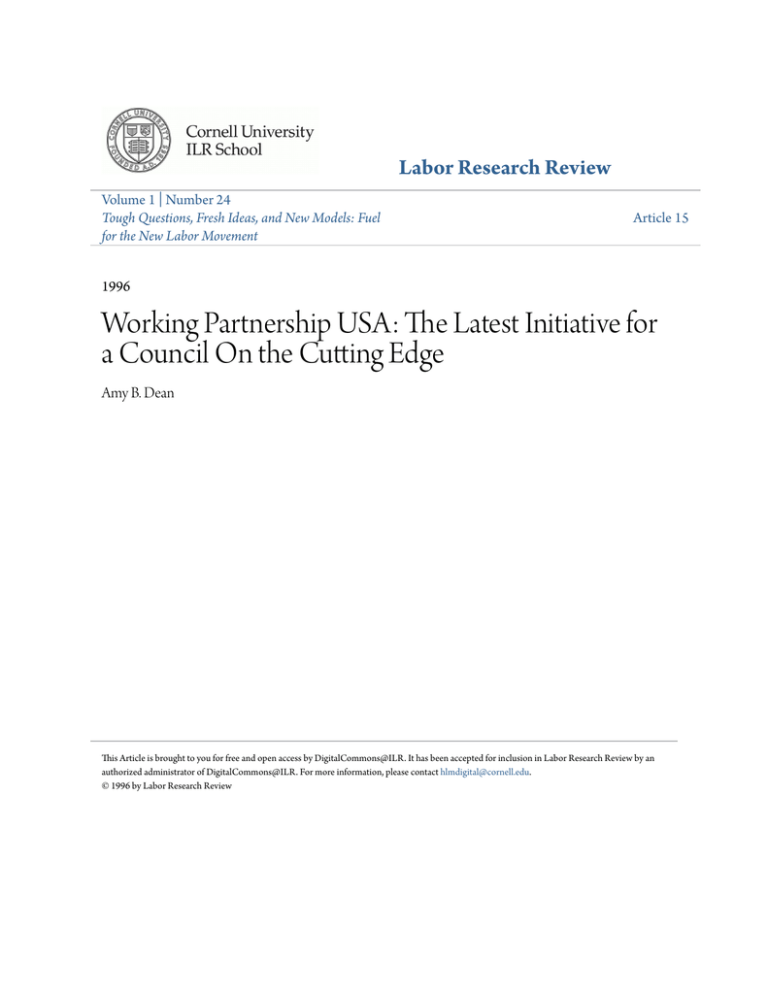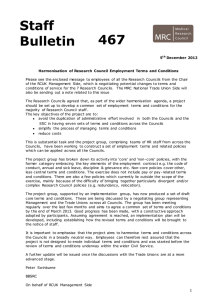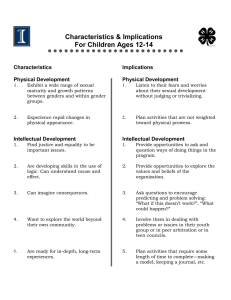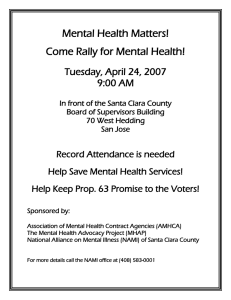Working Partnership USA
advertisement

Labor Research Review Volume 1 | Number 24 Tough Questions, Fresh Ideas, and New Models: Fuel for the New Labor Movement Article 15 1996 Working Partnership USA: The Latest Initiative for a Council On the Cutting Edge Amy B. Dean This Article is brought to you for free and open access by DigitalCommons@ILR. It has been accepted for inclusion in Labor Research Review by an authorized administrator of DigitalCommons@ILR. For more information, please contact hlmdigital@cornell.edu. © 1996 by Labor Research Review Working Partnership USA: The Latest Initiative for a Council On the Cutting Edge Abstract [Excerpt] Inject a dose of innovation and a lot of hard work, and there are over 600 local labor councils across the United States which can be jumpstarted to play pivotal roles in labor's rebirth. Our experience in Santa Clara County (San Jose and "Silicon Valley," California) demonstrates what can be accomplished when a central body moves aggressively to realize its full promise. New initiatives such as establishing a non-profit called Working Partnerships USA to promote an economic justice agenda, and forming the South Bay Campaign Management Institute to train and support labor's candidates are rapidly becoming effective vehicles for political action, economic development, and community organizing. Keywords Working Partnership USA, labor councils, labor movement, union, worker rights This article is available in Labor Research Review: http://digitalcommons.ilr.cornell.edu/lrr/vol1/iss24/15 \ Central Labor Councils W O R K I N G PARTNERSHIPS USA: THE LATEST INITIATIVE FOR A COUNCIL O N THE CUTTING EDGE i Amy 8. Dean Inject a dose of innovation and a lot of hard work, and there are over 600 local labor councils across the United States which can be jumpstarted to play pivotal roles in labor's rebirth. Our experience in Santa Clara County (San Jose and "Silicon Valley," California) demonstrates what can be accomplished when a central body moves aggressively to realize its full promise. New initiatives such as establishing a non-profit called Working Partnerships USA to promote an economic justice agenda, and forming the South Bay Campaign Management Institute to train and support labor's candidates are rapidly becoming effective vehicles for political action, economic development, and community organizing. THE A C T I O N IS LOCAL It's on the local level where the greatest potential exists to develop new organizing models and potent, durable political coalitions. There's an irony here, however, because a main factor reshaping workers' lives is the "new global economy." But at least for the moment, the political impact of globalization has been to accelerate alienation from national politics and breathe new life into localized grassroots activism where people feel the impact of global forces. As the steadily falling level of voter participation indicates, millions are tuning out of national elections. Yet simultaneously, there is a rise in neighborhood action and community involvement. The immediate challenge for labor is to forge a strong connection with the lives of working people through those activities in which they engage with the most enthusiasm. Right now every institution in society—churches, schools, workplaces, and government—is in a process of dramatic change. Against this changing landscape, labor councils stand out for their ability to build bridges between diverse constituencies. Councils are one of the few places where plumbers and teachers, mAmy B. Dean is the executive officer of the South Bay AFL-CIO Labor Council and founder of Working Partnership USA. She formerly served as the labor council's political director. \ 44 Labor Research Review # 2 4 ^U^/? social workers and ironworkers, janitors and nurses can come together to achieve common goals. They are also the place where labor intersects with the community and is propelled into all of society's policy fights. Thus councils provide hands-on opportunities to develop a unifying agenda for social and economic justice that amounts to more than words on paper. Unless we can articulate and fight for a program that goes beyond the immediate institutional interests of unions and speaks for all working people, labor will inevitably be pushed to the political sidelines. PROOF IS IN THE PUDDING The trick is to translate our knowledge of what must be done into on-the-ground results. Here, Santa Clara County's experience is quite encouraging. Historically a progressive focal point, the Santa Clara Council has been a pathbreaker on everything from international affairs to strike support and political action. In the 1960s the body was the first labor council to publicly oppose the Vietnam War. A council strike support committee, built up over decades, has won nationwide recognition for its work. "The Committee has been crucial for providing strike support and enabling us to win our struggles," notes Joan Emslie, Kaiser Director of SEIU 250 and currently is the chairperson of the labor council. "Leaders and members alike have worked to strengthen our movement overall, even beyond each individual union," according to Dennis Hughes, president of UFCW 428, one of the council's biggest affiliates. The council's most recent innovations carry on this proud legacy. Like most central labor councils, we are actively engaged in political action work to counter the Right's initiatives. Our political work began with an agenda that has a regional living wage campaign as its center- \ Fuel for the New Labor Movement 45 piece. With our agenda in place, we have developed a candidate education process to sort out candidates who truly understand and support our platform from those who simply proffer platitudes during interviews. Finally, we back up our candidate endorsement with the South Bay Campaign Management Institute, rank-and-file campaign trainings, and our data base of voter information called "Labor Link." At the Institute candidates and their staff can gain skills in formulating a comprehensive campaign plan. Through separate rank-and-file campaign trainings union members and staff learn the key points of our platform, and the ins-and-outs of political action. Skills training includes campaign planning, effective public speaking, one-to-one communication, and media work. Taken together, these mechanisms not only build our political muscle, they allow us to begin transforming the whole way people "do politics" in Santa Clara County. Bottom line, we're working to change the rules of the game from "candidate driven" to "platform driven." WORKING PARTNERSHIPS USA To complement our arsenal for intervening in electoral politics, the council founded Working Partnerships USA (WPUSA) in January 1995. WPUSA is an advocacy and action 501(c)3 non-profit whose mission is to develop systemic reforms to address the root problems of our current economic crisis. Its work is based upon the premise that labor can play the point role in constructing a labor-community alliance capable of winning majority support for an economic justice agenda. In less than a year, WPUSA has become a player in the regional debate over economic development policy, persuading the County Board of Supervisors to approve tax abatement guidelines that protect the rights of working people and taxpayers, and provide a guaranteed number of good-paying jobs. The significance of our victory in this hotly contested battle was drawn out by Kristy Sermersheim, executive secretary of SEIU 715, the largest public sector union in the county. "I might have a problem opposing tax breaks when those breaks mean jobs for my members; but I have no problem with linking socially defined benefits to public investment. The conservatives have their policy agenda; we have to have ours. And here in Santa Clara County, WPUSA is doing the job." WPUSA is developing a vibrant labor-community alliance that is absolutely essential for meeting the challenge of today's global economy. We need to put forward a program that goes beyond labor's immediate institutional needs and addresses the concerns of all working \ 46 Labor Research Review # 2 4 people. Community as well as labor leaders need to be at the table as we formulate and fight for that agenda. The labor council set up WPUSA to institutionalize this crucial relationship and provide a vehicle to reach the widest possible constituency. It played the pivotal role in crafting WPUSA's mission, getting the project off the ground, and supplying the core of the initial staff. Yet from the beginning we set in place a broad-based board of directors and consultation process involving union officials; housing, economic justice and religious activists; progressive academics; and leaders in the region's communities of color. WPUSA enables us to tackle specific policy issues while combating general prejudices against unions. Polling data in the last decade conclusively reveals the widespread perception that unions are parochial institutions concerned only about their own members and not about the overall public good. At a time when unions represent less than 15 percent of the work force, allowing that sentiment to persist would spell doom for the labor movement. WPUSA is a vital tool for turning that perception around, both by articulating a broad policy agenda and by embodying in its very structure the kind of alliances labor needs to build. In less than a year, WPUSA has forged direct, working ties ("community partners") with area churches and synagogues; grassroots organizations such as the California Network for a New Economy, Silicon Valley Toxics Coalition, and the League of Women Voters; and numerous activists in the women's, peace, environmental, and anti-racism movements. These relationships are of immense importance not only in breaking new political ground, but in gaining support for our locals' strikes and boycotts. Through WPUSA labor also gains experience with the most up-todate organizational forms for political engagement: 501(c)3s. In the last decade 501(c)3s have emerged as cutting-edge mechanisms for business associations, activist groups, and academics to conduct research and advance their policy agendas. The ability of non-profits to tap foundation resources, gain tax-deductible contributions, and gather representatives of diverse constituencies under one organizational roof, have made 501 (c)3s the institution of choice to reach the media, gather talented staff, and influence public opinion and government policy. For 1996, WPUSA's work priorities lie in three key areas: setting a public policy agenda, expanding popular education efforts, and exploring new models of employee organization. First, we're pressing a regional policy agenda which seeks to restore links between the health of industry and the health of communities. That's the basis for WPUSA's efforts to: V Fuel for the New Labor Movement 47 "Wow, a hi-tech, hi-wage future. And get this... no unions!" • work with the City of San Jose's Office of Economic Development to establish the principle of using Economic and Social Impact Reports (just like Environmental Impact Reports) as conditions for development • link public investment and decision-making to formal "communitydefined standards" on jobs and economic development • develop Citizen Watchgroups to monitor corporate compliance with our recently-won tax abatement policy guidelines as well as other guidelines • develop a set of New Economic Indicators that take the real conditions of working people into account when measuring the region's economic health. WPUSA is also rapidly expanding its efforts at popular education to train working people in public policy and economic literacy, and to increase the sophistication of union leadership and community activists. We're in the process of developing "community salons" as a means of building face-to-face contact and meaningful relationships among diverse constituencies. We always talk about building a broad activist base, but all too often there's no walk following the talk. WPUSA salons are concrete efforts to bring unionists and environmentalists, and white workers and immigrant labor to the same table. By encouraging each \ 48 Labor Research Review # 2 4 constituency to articulate its own interests, and also to listen attentively and find areas of common ground, we are building strong alliances at the grassroots. Finally, WPUSA is exploring new models of employee organization. We believe that the next generation of worker organizations will be hybrids, which incorporate some features now identified with professional associations into the trade union model. Current research into public opinion indicates that there would be tremendous support for organizations that fought for wage-and-benefit floors (like current trade unions) while also offering services and professional advantages. In conjunction with pro-labor researchers at the University of California-Berkeley, WPUSA has launched a project to research the specific needs of the contingent workforce, which includes temporary, contract, parttime, and lease employees. WPUSA's role won't be to do the eventual organizing, but to get the ball rolling through further research and advocacy. For example, the labor council organizing committee will work with interested unions to develop long-range organizing plans, which the unions will then carry forward. Capital is organizing itself in new ways, and we need to counter with new forms of worker organization, and vehicles like WPUSA. LEADERSHIP IS KEY As Ms. Sneiderman's article indicates, the labor movement is recognizing the potential of labor councils. The key to councils realizing their potential is dynamic leadership and adequate funding. Too often local federations of labor have been seen as off-the-frontlines resting places for retired or soon to be retired leaders. More than three-quarters of the nation's councils have no full-time staff at all, while most others are forced to get by with a director, a secretary and—if they're lucky—a "community service" officer. This pattern has to be broken. Labor councils are—or should be— right on the firing line, led by a new breed of young, aggressive individuals with sufficient resources to confront our big-money opponents. If we limit ourselves to the shoe-string budgets obtained via per capita levies on local unions we'll never make it. The leadership of today's labor council needs to have a streak of entrepreneurship and work to raise money outside of traditional sources. A reinvigorated trade union movement depends on local labor presenting a strong and attractive face. Let's insist on the best and the brightest. •



